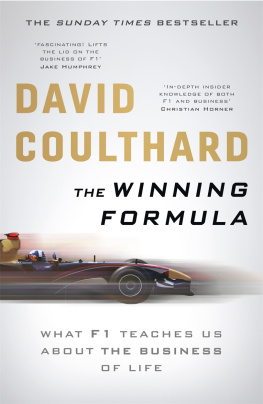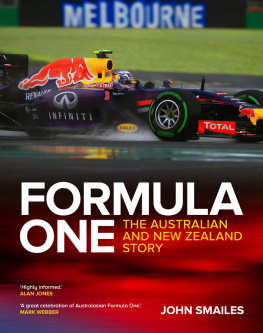CONTENTS
About the Book
Formula One: Made in Britain is one of Formula Ones last untold stories.
As a centre of technical excellence for over thirty years. Britain is at the sharp end of the worldwide motor sport industry, and playing ever harder to win. Most of the sports Grand Prix teams are based in the UK and many of them have British managers and designers who act as a showcase for the UKs skill base past, present and future.
The success of Britains Formula One industry has gone largley unrecognised outside the close-knit world of the racing aficionado. Now, with Formula One: Made in Britain, Clive Couldwell reveals what makes this industry tick and why many of the worlds players choose to come here.
He explores Motorsport Valley, an area which covers the south and Midlands of the UK, where 75 per cent of the worlds single-seater racing cars are designed and built, and talks to many of F1s leading lights.
Winning in F1 depends on innovation and performance-critical engineering, and in this fascinating and insightful book, Clive Couldwell shows how UK research and development are leading the world.
About the Author
In his 23-year career as a journalist Clive Couldwell has reported on just about every major technological event that has shaped our lives. He specialises in explaining how technology and science apply to everyday life and has written extensively for a number of magazines and newspapers including The Times, Evening Standard, The Business, F1 Weekend and J.
Formula One: Made in Britain
The British Influence in Formula One
Clive Couldwell

To my parents, Sheila and Len, without whom this book wouldnt have been possible
PREFACE
Formula One: made in Britain is all about excellence and innovation, about striving to be the best. British manufacturing may no longer be what it once was, but the world of Formula One motor racing grows ever more dynamic, spectacular and exciting, and its a sport that is economically and culturally rooted in Britain, which has been its technical centre of excellence for more than fifty years. We lead the world in this hi-tech industry, said former F1 world champion Sir Jackie Stewart. Mercedes builds its engines in Northampton. The British-built Cosworth engine wins more races than anybody. If you are a top-line designer, you come here. If you want to build a race car, you come here.
Four-times drivers champion Alain Prost vowed never to work in his homeland again after the failure of his team in 2001. Eddie Jordan, who runs his operation next door to the Silverstone circuit, had suggested before Prosts troubles began that he move to Britain. I remember talking to him before the problems and saying wouldnt he be far better off coming to the UK, Jordan recalled. Its far more reasonable in terms of suppliers, people understand motor racing here, and its cheaper to be able to get things manufactured... People here have a much more entrepreneurial idea about their business than in, say, Germany or France... I think that is one of the greatest attributes that Britain has, and why Britain is such an outstanding place from which to run a Formula One team.
For, as Prost found out, Formula One is not just about racing, its also about managing a fast-moving business. All the problems youd experience in a larger company are compacted within a Formula One team, and many bricks-and-mortar operations could learn a lot from how Formula One teams run their businesses, from the processes of product research, development and manufacturing through to marketing. But not many small- to medium-sized businesses are forced to act out their highs and lows on the global stage; nor are their operations scrutinised so intensely.
Watched by nearly 360 million people every two weeks for nine months of the year, the Formula One circuit is almost obscenely competitive and private obsessively so in some cases. Yet the teams products are hardly ever out of the spotlight. The movements of their staff, especially those in the front rank, are monitored and analysed in enormous detail, and their customers the sponsors and fans demand at times impossible levels of perfection, or at the very least improved performance. Above all, they want to be entertained.
In the face of such pressures, it seems remarkable that those small businesses that line up their cars on the grid during the Grand Prix season have made it there at all. The fact that they have is down to their having matured into finely tuned, energetic centres of commercial and engineering excellence. Throughout each developmental, manufacturing and testing cycle, the teams motivated and professional staff who respond positively to the strong leadership of their charismatic principals have been paddling like hell below the water line to keep a variety of projects on track. As a result, they get their products to market on time. Its no surprise, therefore, that business tends to admire Formula One. We all know how difficult organising management diaries for a meet is, commented a former Jaguar executive. Its amazing, though, how those same diaries free up when you say youre holding it at a Formula One factory.
The information technology (IT) industry has an especially close relationship with Formula One because of the link with technology and pioneering excellence. Take Hewlett-Packard, for example, which also requires rapid, high-quality product development. The average time it takes to progress a Formula One car from design to testing is four to six months; product cycles in the IT provider business operate on similar timescales between six and nine months. Formula One teams are also customers with big needs. When it comes to design and materials they are forever working at the cutting edge, always on the lookout for new technologies; they can therefore act as an intelligent user to give the provider company feedback on product performance. At times, a teams service level requirements are also very high, so the IT company sees its client as someone who can help push it to get things done.
Businesses also get involved with Formula One in order to demonstrate to the world that they are big players doing well enough to afford the sizeable price tag. They want and need exposure for their brands globally, said Matthew Argenti, head of international sales at sports marketing company Fast Track. There are no other sports that deliver this kind of branding sixteen times a year, attracting the kinds of audiences they do, and delivering a consistent message to over a hundred countries.
Recently, however, it hasnt been plain sailing for Formula One businesses. Two of the teams that started the 2001 season Prost and Arrows have disappeared, and four of the ten teams contesting the 2003 season Jaguar, BAR, Jordan and Minardi have made redundancies. Of the eighteen teams who were in Formula One when McLaren was dominating the championship back in 1988, thirteen have gone bust. Formula One is both a rewarding and an unforgiving arena.
INTRODUCTION
IN OVER FIFTY years of competition, British Formula One has seen it all speed and spectacle, charisma and competition, domination and disaster. It has blossomed into one of the worlds most glamorous and most professional sports, inspiring intrigue and passion with its mix of cutting-edge technology and high drama.
We should perhaps be thanking for all of this those Second World War military planners who decided to build huge airfields all over the country. The importance these strips of concrete and outbuildings played in helping Britain to become the centre of the modern motorsport industry cannot be underestimated. When the war ended, and the fleets of Allied bombers were grounded, these redundant airfields became ideal racing circuits for motorsport enthusiasts. Silverstone, the Northamptonshire track that sits at the hub of Britains motor racing industry, started life as a base for American B-52 bombers. It holds a unique place in the history of Formula One, having staged the very first round of the official World Championship back in 1950, though it had actually hosted its first British Grand Prix two years earlier in 1948, the airfields perimeter roads and runways roped in as part of the circuit. By the time the circuit joined the championship it just used the perimeter roads. Silverstone has been altered numerous times since, but has always remained one of the fastest and most exciting race tracks on the calendar.
Next page










